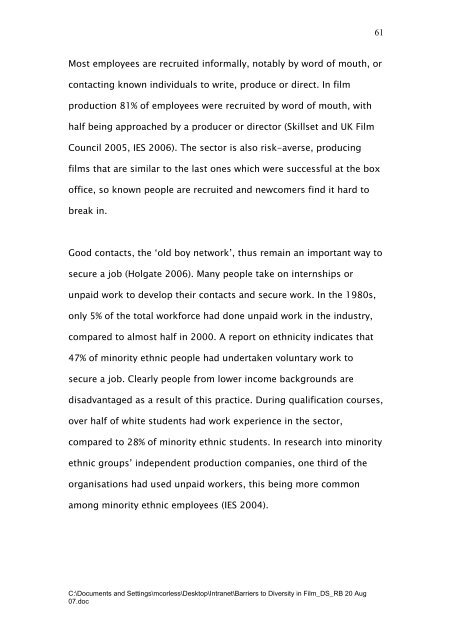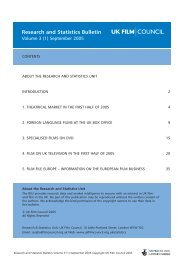Barriers to Diversity in Film – A Research Review – Aug 07
Barriers to Diversity in Film – A Research Review – Aug 07
Barriers to Diversity in Film – A Research Review – Aug 07
You also want an ePaper? Increase the reach of your titles
YUMPU automatically turns print PDFs into web optimized ePapers that Google loves.
Most employees are recruited <strong>in</strong>formally, notably by word of mouth, or<br />
contact<strong>in</strong>g known <strong>in</strong>dividuals <strong>to</strong> write, produce or direct. In film<br />
production 81% of employees were recruited by word of mouth, with<br />
half be<strong>in</strong>g approached by a producer or direc<strong>to</strong>r (Skillset and UK <strong>Film</strong><br />
Council 2005, IES 2006). The sec<strong>to</strong>r is also risk-averse, produc<strong>in</strong>g<br />
films that are similar <strong>to</strong> the last ones which were successful at the box<br />
office, so known people are recruited and newcomers f<strong>in</strong>d it hard <strong>to</strong><br />
break <strong>in</strong>.<br />
Good contacts, the ‘old boy network’, thus rema<strong>in</strong> an important way <strong>to</strong><br />
secure a job (Holgate 2006). Many people take on <strong>in</strong>ternships or<br />
unpaid work <strong>to</strong> develop their contacts and secure work. In the 1980s,<br />
only 5% of the <strong>to</strong>tal workforce had done unpaid work <strong>in</strong> the <strong>in</strong>dustry,<br />
compared <strong>to</strong> almost half <strong>in</strong> 2000. A report on ethnicity <strong>in</strong>dicates that<br />
47% of m<strong>in</strong>ority ethnic people had undertaken voluntary work <strong>to</strong><br />
secure a job. Clearly people from lower <strong>in</strong>come backgrounds are<br />
disadvantaged as a result of this practice. Dur<strong>in</strong>g qualification courses,<br />
over half of white students had work experience <strong>in</strong> the sec<strong>to</strong>r,<br />
compared <strong>to</strong> 28% of m<strong>in</strong>ority ethnic students. In research <strong>in</strong><strong>to</strong> m<strong>in</strong>ority<br />
ethnic groups’ <strong>in</strong>dependent production companies, one third of the<br />
organisations had used unpaid workers, this be<strong>in</strong>g more common<br />
among m<strong>in</strong>ority ethnic employees (IES 2004).<br />
C:\Documents and Sett<strong>in</strong>gs\mcorless\Desk<strong>to</strong>p\Intranet\<strong>Barriers</strong> <strong>to</strong> <strong>Diversity</strong> <strong>in</strong> <strong>Film</strong>_DS_RB 20 <strong>Aug</strong><br />
<strong>07</strong>.doc<br />
61
















